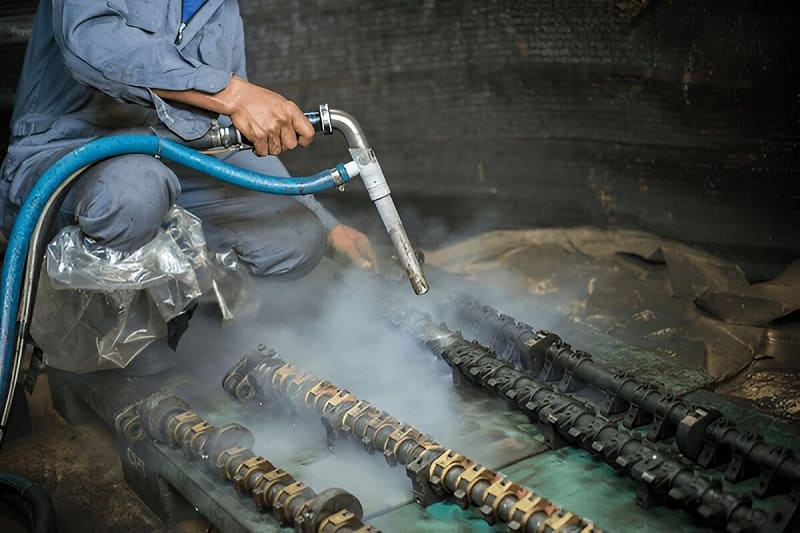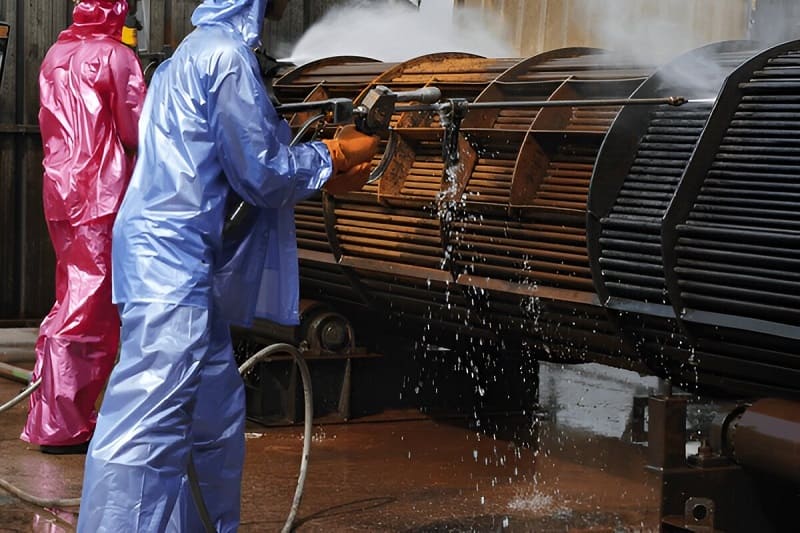Maintaining the cleanliness of the industrial environment and equipment is a crucial component of industrial maintenance. Contaminants and buildup can reduce capacity and operational efficiency, and potentially create hazardous conditions for the crew and the environment.
However, cleaning industrial equipment must be done purposefully with the correct cleaning method. Two standard methods for equipment cleaning in industrial settings include dry ice blasting and hydroblasting. While both are incredibly effective, they must be used appropriately to ensure that no damage is done to the equipment and that it is thoroughly cleaned.
What is Hydroblasting? High-Pressure Water Jet Cleaning Explained
Hydroblasting is similar to water blasting or pressure washing and is also referred to as high-pressure water jetting. This cleaning method uses highly pressurized water to blast contaminants off the surface of heavy machinery, tanks, silos, pipes, and even shipyards. The industrial applications are nearly limitless for this method of cleaning. It is worth noting that hydroblasting cleaning is more effective and much stronger than standard pressure washing or power washing.
Because the pressure ranges from 10,000 to 40,000+ PSI, it has the power to easily clean off built-up residue and sludge without the need for chemicals. This nonabrasive cleaning method is preferred because of its ease, adaptability depending on the need (the amount of pressure used can be adjusted), and how effectively it cleans. This is a highly specialized method of cleaning and does require the proper training and PPE. It is also regulated by OSHA.
What is Dry Ice Blasting? A Safe, Non-Toxic Cleaning Solution
Dry ice blasting is another effective industrial cleaning method, which is more suitable when more delicate equipment is involved. This is similar to hydroblasting in that it uses pressure to clean. In this case, compressed air is used to blast dry ice onto a surface, but when it hits, the dry ice turns into a gas, lifting contaminants from the surface. This method of cleaning is both non-toxic and non-combustible, and like hydroblasting, the pressure is also adjustable.
There are safety considerations that must be made, and this method of cleaning must be conducted by trained professionals with the proper PPE. It’s a perfect method to be used in food processing and manufacturing because it doesn’t use harsh chemicals and is nontoxic, but it is also suitable for a myriad of industrial applications, including automotive, power generation, and more.

Hydroblasting vs. Dry Ice Blasting: Key Differences
Both hydroblasting and dry ice blasting are incredibly effective industrial cleaning methods, and both are adjustable to suit the strength required to blast away debris and buildup. Dry ice blasting is a little more delicate than hydroblasting, so it’s more appropriate for surfaces that a stronger blast could damage than hydroblasting provides.
Hydroblasting is a great, environmentally friendly application, but extra care must be taken as the discharge water may contain contaminants that are blasted away. This means that what’s left over after the clean must be appropriately cared for with the appropriate contaminant and drainage solution.
Dry ice blasting is also environmentally friendly, but it may not be as effective on super stubborn buildup. Additionally, proper care must be taken with the dry ice to ensure safety when it comes to storage and handling.
When to Use Each Method
There are certainly a number of pros and cons for hydroblasting and dry ice blasting methods of industrial cleaning, and, depending on your needs, one may be a better choice over the other.
Hydroblasting is an excellent choice for prep work before recoating ships, tanks, or even bridges or other structures because it can clean the surface and ensure that the new coat will properly adhere. The power of hydroblasting is also perfect for removing stubborn, thick sludge, buildup and debris in heavy industrial settings.
Dry ice blasting is ideal for use in food processing or manufacturing because it is food-safe. There is no worry about contaminants or bacteria because this method of cleaning stops microbial growth and gets rid of buildup without chemicals. This food-safe application would meet compliance and regulatory requirements with ease. That said, it can also be used in sensitive or electrical applications, and can clean equipment without requiring total dismantling. It can even be used in mold or fire remediation.
Safety Considerations for Hydroblasting and Dry Ice Blasting
Both of these industrial cleaning applications require proper safety measures and adherence to local, state, and federal regulations.
The high-pressure of hydroblasting could cause serious injury — easily cutting through limbs and digits if mishandled. This requires complete PPE that includes cut-resistant suits, gloves, face shields, and more. The equipment must be regularly inspected and used in accordance with OSHA standards. As previously mentioned, water runoff must be properly managed, as it can contain contaminants that could seep into groundwater or sewer systems if not handled correctly.
When it comes to dry ice blasting, proper ventilation must be in place as the dry ice creates carbon dioxide gas, which could remove oxygen and even cause asphyxiation in poor conditions. Those operating dry ice blasting equipment must wear gloves and have proper PPE that will protect them from frostbite and other serious injuries that can occur when coming into contact with dry ice.
Get Expert Help Choosing the Right Industrial Cleaning Method
There are several differences between hydroblasting and dry ice blasting, but both are effective cleaning methods that leave your industrial equipment and environment free from debris, contaminants, and buildup. Both require a professional applicator to ensure the safety of staff and crew. When considering which method to choose, consider the company you’re working with, its experience, and its reputation. With a company like Environmental Remedies, you can count on all three.
Are you unsure which option is best for your industrial setting? Our team can help guide you through the best option with a personal consultation. Contact us for more information about how we can help your business!
Frequently Asked Questions
Q: Is Hydroblasting safe for all surfaces?
A: No. While hydroblasting is highly effective, its high-pressure stream (up to 40,000 PSI) can damage delicate surfaces. It’s best suited for heavy-duty applications, such as tanks, ship hulls, and industrial machinery.
Q: Can dry ice blasting remove paint or rust?
A: Dry ice can remove some paint and surface contaminants, but it’s less aggressive than hydroblasting. For heavy rust or thick coatings, hydroblasting is usually more effective.
Q: Which is more environmentally friendly – hydroblasting or dry ice blasting?
A: Both are eco-friendly compared to chemical cleaning. Hydroblasting uses only water, while dry ice blasting uses solid CO2 that sublimates into a gas without leaving residue. However, hydroblasting produces wastewater that must be managed appropriately.
Q: Is dry ice blasting safe for food processing equipment?
A: Yes. Dry ice blasting is FDA-approved for use in food processing environments because it’s non-toxic, non-abrasive, and inhibits microbial growth without the use of chemicals.






